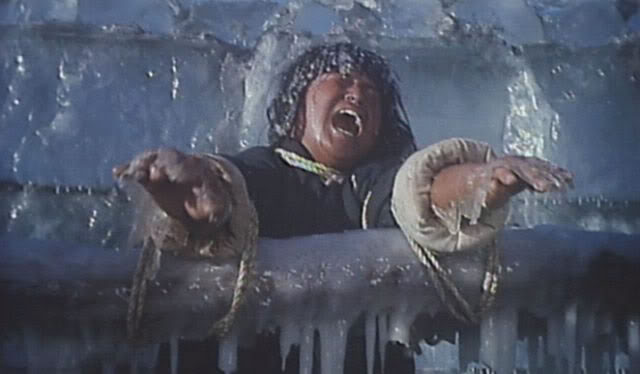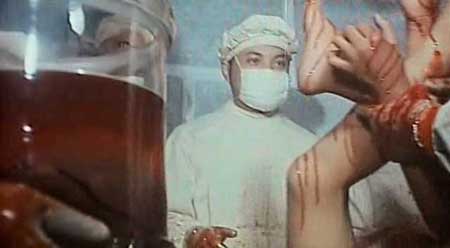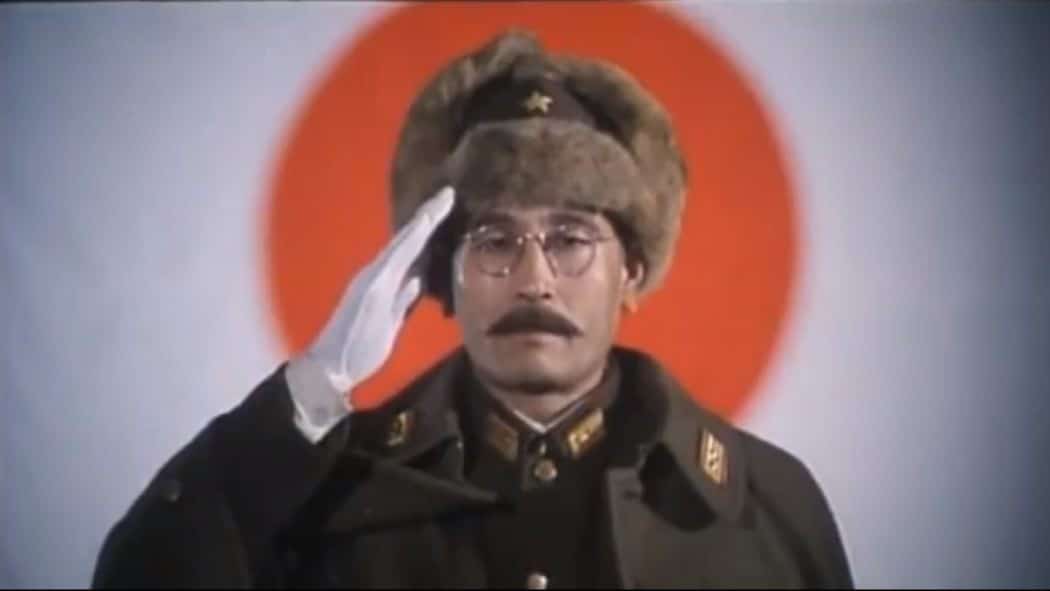 Editor’s note: this discussion of Men Behind the Sun contains spoilers.
Editor’s note: this discussion of Men Behind the Sun contains spoilers.
The Chinese film Men Behind the Sun (1988) is not altogether well known in the West, and has yet to enjoy the kind of lavish DVD or indeed Blu-Ray release which has usually happened for even the most censor-baiting movies by thirty years after their creation. Those who have not seen the film itself, but know a little about it, will probably know about its notorious reputation for gore, perhaps for several key scenes in particular; before I ever got hold of a copy, I knew about ‘the autopsy scene’ and ‘the frostbite scene’ from hushed discussions in magazines and fanzines, for example, and I’m willing to bet many readers here will have heard similar things. These scenes are still, undeniably, important and shocking in the extreme (and more so, when you learn a little about how they were done) but I think it’s a real disservice to the work of director Tun Fei Mou if his film is known only for these. These scenes, and others like them, should never exist in isolation in our imaginations – as merely grisly little tableaux to be relished by gorehounds. Men Behind the Sun is a phenomenal film, in which even the most seemingly outlandish scenes have their basis in historical fact, and however appalling the scenes are to watch, they’re of vital importance to the narrative of the film as a whole. In essence, the entire film is a scream of agony by the Chinese about their WWII treatment at the hands of the Japanese; its rage is measured and doled out in a well-constructed, engrossing story. I will acknowledge that it’s difficult to watch. But I feel that anyone with even a passing interest in the history of the Far East should see it, and should be upset by it. These things should upset us, and should be acknowledged.
As the film explains in its opening scenes, aggressive Japanese empire-building in the early decades of the twentieth century had seen it conquer wide swathes of the Far East, including Korea and parts of China. Expansionist ideals were by no means and have never been the exclusive tenure of the West, and so the Japanese occupied parts of countries which they considered to be populated by people decidedly less cultured than themselves. Throughout the decade, closer and closer relations with Nazi Germany – though often problematic – saw the Japanese essentially following a similar path of conflict, taking territory whilst prevaricating in its attitudes and alliances with the global powers by now in play. They also committed themselves to a small-scale, but no less brutal nor important programme of medical experimentation, targeted towards boosting their war efforts, but as with the experiments eventually undertaken by the Nazis in Europe, also overlaid with the pure cruelty of curiosity, when that curiosity finds subjects deemed less than human.
The district of Manchuria (North-East China) was under complete Japanese control after 1931. It was in this region that the Japanese established Unit 731, their flagship biological and chemical warfare research facility. At the end of the war, the Japanese did a remarkable and meticulous job of covering their tracks, destroying many records of what had taken place, but enough has survived to reveal a sadistic programme of experiments performed upon mainly the Han Chinese, though also on Soviets, Allies, Mongolians and Koreans. Men Behind the Sun is a film about Unit 731, and the young (almost child) Japanese soldiers forced to help oversee operations. In order to equip them to do their new jobs, the camp’s military and medical hierarchy has to essentially break down their humanity. The boys can no longer see the local Chinese as simply people, but as ‘marut’ – literally ‘logs’, but a word which I believe translates best as ‘guinea pigs’, simply fodder for experimentation. They try to be obedient, as any good Japanese soldier would; they prevaricate, however, when the cruelty of their masters impinges upon their lives in the most brutal way, when a local child who has been their friend is taken, killed and his organs harvested. He’s taken so quietly, because the boys themselves are told to bring him, and he trusts them. Their sense of betrayal is authentically upsetting to watch and phenomenally acted by the young cast.
 To make this scene (one amongst many) even more skin-crawling, rumours that this scene contains a real autopsy turns out to be quite true. When a local child died in an accident, Tun Fei Mou somehow prevailed upon the doctors performing the child’s post-mortem to allow him to use footage: the deceased was about the same height and weight as the child actor for the scene, so it has that unsettling note of veritas. The doctors (incredibly) accommodated his request, even dressing in Japanese uniform to complete the procedure. The organs we see being removed are, so we’re told, pig organs rather than human, though it seems an odd concession to modesty when we’ve just seen a real child’s corpse being cut into. Likewise, the notorious ‘rats can overpower a cat’ scene where a cat is apparently mauled to death by rats is now being denied as real by the director, though it looks very, very much like an animal genuinely dies here. This sort of thing could of course never, ever happen today, and it’s bizarre that it ever did, but even if we can’t quite accept it, we can perhaps explain it by the fact that at this time, there was no SFX industry in China, and Tun Fei Mou felt it was of the utmost importance to show the experiments as they really were. He couldn’t have found anyone to make rubber models for key scenes, and even if he could, perhaps this would have gravely affected the film he was trying to make.
To make this scene (one amongst many) even more skin-crawling, rumours that this scene contains a real autopsy turns out to be quite true. When a local child died in an accident, Tun Fei Mou somehow prevailed upon the doctors performing the child’s post-mortem to allow him to use footage: the deceased was about the same height and weight as the child actor for the scene, so it has that unsettling note of veritas. The doctors (incredibly) accommodated his request, even dressing in Japanese uniform to complete the procedure. The organs we see being removed are, so we’re told, pig organs rather than human, though it seems an odd concession to modesty when we’ve just seen a real child’s corpse being cut into. Likewise, the notorious ‘rats can overpower a cat’ scene where a cat is apparently mauled to death by rats is now being denied as real by the director, though it looks very, very much like an animal genuinely dies here. This sort of thing could of course never, ever happen today, and it’s bizarre that it ever did, but even if we can’t quite accept it, we can perhaps explain it by the fact that at this time, there was no SFX industry in China, and Tun Fei Mou felt it was of the utmost importance to show the experiments as they really were. He couldn’t have found anyone to make rubber models for key scenes, and even if he could, perhaps this would have gravely affected the film he was trying to make.
Real body parts are used for all of the film’s most horrific scenes. This includes the infamous scene I alluded to above, where a marut Chinese woman (fresh from having her surplus-to-requirements newborn smothered to death in the snow) is given slow, prolonged frostbite by having her arms extended through a hole in an outside wall into the freezing winter conditions. When her arms are completely dead, she first has her arms thawed in warm water, and then Dr. demonstrates how you can then skin the flesh from the bones; it flays off easily. The actress playing this part – Mou’s niece – held a real corpse’s arms out into the subzero temperatures in order to freeze them, nearly getting frostbite herself, and then holds onto them for the main scene. The overall effect is utterly repellent and – as revealed in a 1995 New York Times article, whose author was made privy to Japanese testimony – it really happened to people. Limbs were really frozen and flayed. Limbs were bludgeoned, to see if any feeling remained. The overall feeling I get from this scene, apart from obviously flinching, is the director’s real sense of anger that this ever happened to Chinese people. We’re forced to look at this in as exact a replica of the events in question as it is feasible to give, and the impact is immense. Of course, viewers are welcome to look at it simply as a gory scene and thousands no doubt have, but I think it’s missing the point.
I won’t simply talk through every scene in this horrific history lesson, but I will say I feel none of them are chosen simply by chance, or to shock for their own sakes. The effect of the film is to steadily, unhesitatingly paint a picture of a unique point in history, with content always rooted firmly in that history, and underpinned by character studies which give the film its strongest juxtapositions. The sadistic personality of Shiro Ishii, for example, is a man devoted to Japan, whose big break in the progress of biological warfare comes from a laugh he has after a trip to a brothel. You can spread bubonic plague, he realises, by distributing infected fleas in porcelain bombs. And of course, this is also true. It’s worth bearing in mind that this man was given immunity by the Americans after the war, and continued to work, turning up at front-line institutions to wield his expertise. In fact, after offering us another gruelling juxtaposition (the Japanese woman who gives birth as the camp burns, giving us one last glimpse of life opposing death) it is revealed to us that Shiro’s Eureka moment led to a real outbreak of bubonic plague in Manchuria. Plague, which was at one time scheduled for use against California, had Japan not surrendered after America unleashed atomic bombs upon them…
“Friendship is friendship; history is history.”
When Men Behind the Sun was first made, it offered, interestingly, something of an issue for the modern China which had produced it: China was, by this point, keen to keep a good working and economic relationship with Japan, now a neighbour with whom it had long enjoyed peace. This neatly underlines how much the world had changed by this point, with young Chinese and Japanese people being gripped by so little of the negativity which would have been hugely significant to even their nearest ancestors. It is right and good that the sins of the fathers should not spill over into modern China or Japan; an ever-dwindling number of people even survive who could have been implicated in any of these events, and no one benefits when new generations are made to labour under whatever modern version of original sin we now think is befitting.
However, nor should we shy away from unpalatable truths. Where many historical films can be taken to task for tinkering with history, rendering it more tolerable or even misrepresenting recorded facts in order to offer a different version of events, Men Behind the Sun is rather different fare, and audiences were unsurprisingly shocked by it all, with Japanese audiences in particular finding it hard to bear. Several sequels followed, each in turn examining more unpalatable histories, though never quite as shockingly as Men Behind the Sun did. This film does everything it can to tell its story, taking every opportunity to show us what is strongly believes in, with no need to embellish, and a wholesale rejection of glossing over anything. This it does by shocking means, and by using methods which would today be illegal. This means that Men Behind the Sun has more of a reputation as an exploitation movie, an understandable but, to my mind misleading state of affairs which threatens to dismiss a unique film about a little-known period of time. It’s a period in time, it’s worth remembering, which was very nearly kept secret forever. Had the Japanese officials at Unit 731 been any more thorough in its cover-up, no one would ever have known what befell tens of thousands of people who ended up there.
I can end this feature with nothing further other than to reiterate my belief in the film’s essential worth, and to point again to the quote which runs over the film’s opening credits (quoted above) – words which sum up the weight of the past, without succumbing entirely to it. The world into which Men Behind the Sun was released was indeed benefiting from friendship with the old adversary, but nothing can ever take away what had happened, and a film of this calibre and nature ensures that we learn from the bloody lessons of history. It’s a fitting and a sobering legacy.
